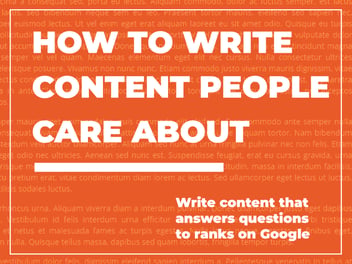
The Ultimate Guide to AI Blog Writing: How to Write a Blog Post Using AI Writing Tools
This post may contain affiliate links, which means I may receive a commission if you click a link and purchase something that I have recommended. Thank you!
In the fast-paced realm of digital content, the pen is mightier when powered by artificial intelligence. Welcome to the dawn of AI-assisted writing, where the click-clack of keyboard keys meets the silent hum of machine learning algorithms. As someone who's dipped their quill in many an inkwell and navigated the tides of tech evolution, I've witnessed firsthand how AI has revolutionized the way we craft narratives.
It feels like just yesterday that we wrote a blog post similar to this! In fact, back in January, we wrote "Can AI Write Blog Posts", which we used ChatGPT3 to generate. It was.... rough around the edges to say the least... But it felt revolutionary for its time. Today, ChatGPT 4.0 - Turbo is publically available and it truly demands a second look.
We took that second look and now use slight variations of this SOP for every post written on our website. This process took us from unable to find time to write even a single blog post a month, to being able to write one every day and more for our own customers! In fact, this entire blog post was written using the same process outlined below.
What's This Guide All About
This guide isn't just about scribbling words on a digital canvas; it's about orchestrating a symphony of algorithms to echo your voice. Whether you’re a solo blogger or a content maestro managing a choir of writers, AI writing tools are the new instruments that can elevate your prose from the pedestrian to the sublime.
Training an AI to write not only involves feeding it examples of your work but also instilling your moral compass within its code. It's not a mere mimicry game; it's about expanding ideas and adding depth to the conversation. It's about creating content that resonates, reflects your ethos, and reaches into the heart of your audience. Drafting an outline with an AI is akin to a duet where each performer complements the other. The AI proposes a structure, you refine it, and together you ensure the keywords hit the right SEO notes. It’s a dance of human intuition and machine precision, leading to content that ranks as well as it reads.
And as we split this digital manuscript into parts, we'll see how segmenting our outline can turn a monolithic task into manageable pieces, primed for AI's touch. Each section is an opportunity to review, to curate, and to perfect.
But words alone won't capture the audience. Today's readers are visual voyagers, seeking multimedia experiences. Embed videos, enliven your text with AI-generated images, and watch as your blog transforms into a tapestry of interactivity.
Join me as we embark on this journey, unraveling how AI can become the powerful ally in your quest for content creation. For those who find the clock’s relentless tick to be the nemesis of creativity, worry not. By the end of this guide, you'll see why many, including myself, have embraced AI as a partner in prose.
Selecting the Right AI Writing Tools

In the digital cosmos where content is king, the quest to write a blog post that captivates and converts is unending. The rise of AI for blog writing has been nothing short of a revolution, providing a new set of writing tools to craft high-quality content. But with great power comes great responsibility—the responsibility to choose the right AI writing tool.
When you decide to use AI to generate blog content, it's crucial to pick a tool that aligns with the pulse of your narrative. A robust AI blog writer should not only understand the nuances of your topic but also the intricacies of your voice. It's about harnessing artificial intelligence to create high-quality, long-form content that resonates with your audience.
Let's cut to the chase and see what you'll gain from this guide:
- Understand how AI can amplify your content creation process.
- Learn to integrate AI tools into your writing routine for improved efficiency.
- Discover the balance between AI assistance and your unique creative voice.
What Makes A Good AI Writing Tool?
The ideal AI writing software serves as an AI assistant, helping you to write blog posts that are not just informative but also engaging. The tool should provide more than just grammatical corrections; it should offer suggestions that elevate your writing. As you create content, these AI tools should be capable of suggesting content creation strategies, content marketing insights, and high-quality content development techniques.
Remember, the right AI content writer can amplify your creativity, not stifle it. It should provide a seamless experience where AI-generated content meets human empathy and insight. Whether you're looking to generate an outline or produce a solid blog post, your chosen AI should help write with precision and flair.
So, as you sift through the plethora of AI writing apps available, consider not just the sophistication of the AI technology but also its synergy with your writing style. After all, the goal is to make your blog stand out in a sea of content, and the right AI tools can be the wind in your sails.
At the time of writing this article, we use a combination of ChatGPT 4-Turbo and NeuronWriter to generate all of our web content for our blog. I really can't praise NeuronWriter and ChatGPT enough here. These two tools in combination with one another take my content generation to a whole new level.
Julian Goldie did a great job of outlining this workflow here.
Here are the key takeaways for choosing an AI writing tool:
- Ensure the AI tool matches your writing style and content goals.
- Look for AI that offers both grammatical assistance and stylistic enhancements.
- Consider AI tools that provide SEO insights and content strategy suggestions.
Train Your Writer AI

Embarking on the journey of AI blog writing, it's imperative to tailor your AI writing tool to reflect the essence of your own quill. Like a seasoned novelist handpicking a typewriter, select an AI tool that learns from your prose. Feed it examples of your past work; let it absorb your rhythm, your tone, your soulful punctuations. This is where AI for blog transforms from a mere tool to a learned apprentice.
Training your AI goes beyond mere imitation; it's about sculpting your AI blog writer into a guardian of your brand's ethos. It's teaching the AI the subtlety of inspiration versus the bluntness of replication. Your content writing should be a mirror of your intellect, not a shadow of someone else's. Therefore, set moral boundaries for your AI—ensure it expands upon ideas, rather than pilfering them.
Artificial intelligence in writing is a powerful ally, but without direction, it can lead to a wilderness of content. Help you write blog posts that are original, that tell your story, and that drive the narrative forward. The AI-generated content should be a tapestry woven with threads of your own making, not a pastiche of the internet's vast expanse.
By setting the right parameters and providing clear examples, your AI content writer will begin to create content that's not only high-quality but also infused with the uniqueness of your voice. It’s about leveraging AI writing tools to create a symphony where the notes are yours, and AI simply helps them resonate louder.
My workflow involves giving ChatGPT a few blog posts that I feel capture my personal writing style well. At the beginning of every chat window, I ask GPT-4 to review a few of the articles that were written entirely by me and then tell me about that writing style. If I'm happy with its response, I continue on with the rest of the process and ask it to write in that writing style.
To effectively train your AI writing tool, remember these points:
- Provide the AI with samples of your writing to learn your style and tone.
- Set ethical guidelines for your AI to promote originality in content creation.
- Use feedback to continuously improve the AI’s performance and output.
Draft Your Outline To Help Write Blog Content Effectively
The skeleton of a compelling blog post is its outline, a blueprint where you map the journey for your readers. With an AI writing assistant by your side, you can generate an outline that not only structures your thoughts but also anticipates the needs of your audience. It's about using AI to write blog posts that are architecturally sound and content-rich.
But do not simply settle for the first draft your AI tool presents. Review it with a critical eye—expand and refine it until it encapsulates all the points you wish to cover. This is not just about having a solid blog outline; it's about ensuring that the skeleton is robust enough to support the flesh of your words.
Incorporate SEO-rich headlines into your outline. Delve into keyword research or deploy other AI SEO tools to ensure that your content doesn’t just sing, it also gets heard. Your headlines should serve as beacons, guiding the digital flotsam to the shores of your blog.
Split your outline into sections, each a stepping stone that leads the reader through your narrative. Consider the flow of information, the journey from problem to solution, from question to answer. Here, AI can help write sections that are clear, concise, and focused—each with an estimated word count to maintain balance and pacing.
This process is a tango between your creative flair and the analytical prowess of your AI blog writer. Together, you craft an outline that is not just a guide, but a promise—a promise of value, insight, and a journey worth taking.
Sometimes I just ask GPT-4 to write up an outline for a blog post based purely on the title and no additional context. Then, I edit the headlines and outline to fit into what I'm actually trying to write before moving onto the next part of our process.
Crafting an effective outline with AI involves:
- Collaborating with AI to structure your blog post for maximum impact.
- Fine-tuning the AI-generated outline to fully encompass your intended message.
- Incorporating SEO strategies from the beginning to ensure content visibility.
Split Your Outline into Manageable Sections
The art of blog writing is akin to painting; you start with broad strokes to outline the vision and then refine each element with focused attention. Splitting your outline into sections allows for a content creation process that is both manageable and meticulous. It’s a method that ensures each part of your AI-generated content is given the care it deserves.
When you write a blog post, consider each section as a chapter in a novel, each one should stand on its own merit while contributing to the overall narrative. Your AI writing tool can assist in this process, suggesting headings and subheadings that keep your content on track. Assign a word count to each section, setting clear targets for your AI blog writer to achieve. This structure not only aids in the writing process but also in ensuring that your SEO efforts are evenly distributed throughout the article.
Use AI to generate each section, but remember that the AI is a tool, not the artist. It can suggest, create, and even inspire, but the final touch—the human touch—will always be yours. As your AI assistant proposes text, it's your role to infuse personality, to inject the nuances that make your writing uniquely human.
AI also currently struggles with some long-form content (like entire blog posts at once)... which, if we're being honest, is the primary reason why we split our outline into multiple sections.
With each section crafted, you're not just building an article; you're constructing an experience. The use of AI writing software here is to expand your capabilities, not limit them. Through this collaborative process, you can produce high-quality blog content that resonates with authenticity and provides genuine value to your readers.
Dividing your outline into sections aids in:
- Focusing on detailed development of each part of your blog for depth and clarity.
- Assigning specific word counts to maintain balance and meet SEO requirements.
- Allowing for targeted AI assistance in each section for consistency and coherence.
Write Blog Posts by Section Using Artificial Intelligence

With the outline segmented and the direction clear, it's time to begin writing the blog post, imbuing life into each section with the assistance of your AI writing tool. Each paragraph you craft with AI for blog content should pulse with the vitality of your unique insight, blended seamlessly with the computational efficiency of AI.
As you write a blog post, let the AI content writer lay the foundation. However, it’s crucial to remember that AI-generated content requires a discerning eye. Review, review, review! AI is adept at suggesting content, but it can sometimes veer off course, imagining internal and external links or details that might not be accurate or relevant. It’s your task to ensure that every piece of information is correct and every cited source is trustworthy.
This stage is where your expertise shines—the AI blog writer may propose a structure, but you refine the raw output into polished prose. As a content creator, your role is to enhance the AI writing with anecdotes, examples, and personal insights that no machine could mimic. It is the quintessence of your experiences that will turn informative sections into compelling stories.
And although OpenAI recently introduced "Copyright Shield", I'd prefer to not just yoink content for my own site and let them deal with the consequences... Which is why we strive to review each of our articles prior to publishing.
AI writing tools offer unparalleled support in drafting content, but they do not replace the need for human editorial oversight. They are instruments in your content creation orchestra, and you are the conductor. It’s your vision, your standards, and your voice that will ultimately resonate with the reader.
Here's how to write blog posts by section with AI:
- Use AI to draft each section, then infuse it with your personal insights and expertise.
- Thoroughly review AI suggestions for accuracy and relevance to your topic.
- Maintain the narrative flow and your unique voice throughout each section.
Enhance Your Post with Multimedia
In the digital age, a blog post is more than just words on a screen—it's an immersive experience. Embedding multimedia such as YouTube videos not only adds depth to your blog content but also enhances user engagement and SEO. It's about creating a multisensory journey that complements your narrative.
While AI tools to generate text are invaluable, the visual aspect is where you can really captivate your audience. AI to suggest imagery can be a game-changer, allowing you to generate content that is visually appealing. However, ensure that the visuals are relevant and elevate your message, rather than merely being decorative.
Using AI-generated images can also solve the problem of finding high-quality, copyright-free images, offering a tailor-made visual experience that aligns with your content. It's about using AI for blog aesthetics as much as for the writing itself. But remember, even with AI assistance, the selection and placement of images should be done with a strategic eye.
Incorporate multimedia elements that support and enhance your points. If discussing a complex topic, consider embedding an explanatory video. If you want to evoke emotion, a well-chosen image can speak volumes. The right multimedia can transform a good post into a great one, and AI can help you assemble these elements seamlessly.
To enrich your blog post with multimedia, consider these tips:
- Select images and videos that are directly relevant to your content.
- Use AI to suggest multimedia that complements and enhances your writing.
- Strategically place multimedia elements to break text and engage readers visually.
Publish Your AI Content
After the meticulous process of crafting your blog with AI blog writing tools, the moment of publication is akin to a ship's maiden voyage. You've charted the course, prepared every detail, and now it's time to set sail. But the journey doesn't end at publication; it merely enters a new phase.
Publishing your blog post is just the beginning. What follows is the strategic dissemination of your content across various platforms to maximize reach and impact. Utilize social media, email newsletters, and other distribution channels to ensure your crafted piece finds its audience.
Post-publication, you must engage with your readers, responding to comments and feedback. This interaction not only fosters a community around your blog but also provides valuable insights for future content. The data gathered post-publishing can feed back into your AI tools, allowing them to learn and adapt, improving the AI's ability to generate more targeted content in the future.
Moreover, monitor your blog's performance through analytics tools. Understanding reader behavior, traffic sources, and engagement metrics will inform your content strategy and SEO efforts. This continuous loop of publication, promotion, engagement, and analysis is crucial in the digital content ecosystem.
Remember, the power of AI extends beyond writing. It can aid in understanding trends, predicting reader preferences, and even suggesting adjustments to published content to improve performance. Embrace the full spectrum of AI capabilities to not only create but also to cultivate and curate your blog's presence in the digital world.
After creating your content, focus on these key aspects:
- Promote your content across multiple platforms to reach a wider audience.
- Engage with your readers to build a community and gather feedback.
- Utilize analytics to refine your content strategy and AI’s learning process.
Embracing AI in Blogging: Key Takeaways for Crafting Future-Proof Content
The tapestry of blog content creation is intricate and multifaceted, with AI writing tools acting as both the loom and the weaver's hands. As we've navigated through the process of using AI for blog writing, it's clear that artificial intelligence has the potential to amplify our creative expression, not diminish it.
AI can help write blog posts that are not only high-quality but also deeply personal and engaging. However, it remains a tool—a very powerful one—that should be guided by the human touch. The AI-generated content must be curated with a keen eye to ensure it maintains the authenticity and the voice that your readers connect with.
While AI blog writers can streamline the writing process, they cannot replace the passion and unique perspective that you, as a creator, bring to the table. It is this synergy between human creativity and machine efficiency that can produce truly compelling blog posts.
In this fast-paced world, time is a commodity, and while AI writing tools can save you a significant amount, they still require oversight. If you find that time is still slipping through your fingers, consider partnering with a team that specializes in AI content creation. Our expertise at Zealous Sites in blending AI capabilities with content marketing strategies can help you maintain a dynamic blog without sacrificing quality or personal flair.
In summary, here are the crucial points to remember when using AI in blogging:
- AI is a powerful tool that needs to be directed by human creativity and oversight.
- The authenticity and unique perspective of the writer are irreplaceable by AI.
- The synergy between AI and human input can lead to high-quality, impactful blog posts.
- Continuous learning and adaptation are key to leveraging AI in content creation.
Frequently Asked Questions About AI Blog Writing
Can I use AI to write blog content?
Yes, you can use AI to write blog content. AI writing tools like OpenAI's GPT-3 and others have been designed to assist with various aspects of writing, including generating ideas, creating drafts, and even refining the final piece of content. These tools work by processing large amounts of data and learning how to predict and generate text that is similar in structure and theme to human-written text.
How do I automate a blog post with AI?
To automate a blog post with AI, you would typically follow these steps:
-
Choose an AI Writing Tool: Select an AI writing assistant that best fits your needs in terms of language quality, customization, and user interface.
-
Provide a Prompt: Give the AI a clear and detailed prompt about the topic you want to cover. This could include keywords, the tone of voice, style, and any specific points you want to address.
-
Generate Content: Let the AI generate a draft based on your prompt. Some tools offer structured outlines or entire sections of content.
-
Edit and Refine: Review the AI-generated content for relevance, accuracy, and coherence. Make necessary edits to ensure it aligns with your blog's voice and standards.
-
Optimize for SEO: If needed, use additional AI tools for SEO optimization to ensure your blog post will rank well on search engines.
-
Schedule or Post: Once the content meets your satisfaction, you can use blog management tools to schedule or post the content on your site.
What is the best free AI for blog writing?
As of my last update, there are several free AI writing tools available, but their features might be limited compared to paid versions. Tools like OpenAI's GPT-3 may offer a free trial, and other platforms like AI21 Labs' Jurassic-1 or Zyro's AI Content Generator can provide basic writing services without cost. It's best to research the current options since offerings and features change rapidly.
Honestly, my recommendation is to just pay for GPT-4 at OpenAI. They don't have an affiliate program or I'd definitely be one and add a nice little affiliate link here. Instead, here's just a normal link instead. haha.
And NeuronWriter takes it to a whole new level. They have a Lifetime Deal that I signed up for that has literally already paid for itself. They also offer a free trial here.
Is it legal to use AI to write articles?
Yes, it is generally legal to use AI to write articles. Many content creators and companies use AI to assist with content generation. However, it's important to use these tools ethically, ensuring that the content is original and not plagiarized, and giving credit to the AI tool if required by the tool's terms of service.
Can you use AI to write articles?
Yes, you can use AI to write articles. AI can be an effective tool for generating draft articles, providing suggestions for improving your writing, and even creating entire pieces of content. However, human oversight is necessary to ensure that the articles meet quality standards and are appropriate for your audience.
Is AI written content copyright free?
AI-written content is not automatically copyright-free. Copyright laws can be complex and are still catching up with AI technology. Generally, the content generated by AI could be considered the intellectual property of the user who prompted and edited it, or possibly the company that owns the AI, depending on the terms of service of the AI provider. It's essential to understand the terms of use of the specific AI tool you are using.
Can AI generated articles be detected?
Yes, AI-generated articles can often be detected, especially by those who are familiar with the nuances of AI writing styles or by using specialized detection software. These tools and individuals might look for patterns that are commonly associated with AI writing, such as certain repetitions, overly formal language, or a lack of deep context that is more common in human writing.
Can I post AI generated articles?
Yes, you can post AI-generated articles, but it's important to do so responsibly. You should review and edit the content to ensure it meets your publishing standards and is factually accurate. Additionally, depending on the platform you're using to publish, you should ensure you're in compliance with their content policies, which may have specific rules about AI-generated content.
Always remember that while AI can greatly assist in the content creation process, the responsibility for the content's quality, originality, and legality ultimately lies with the human publisher.


